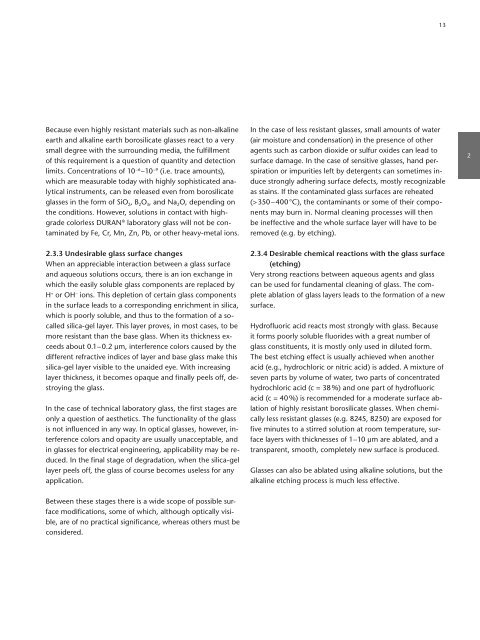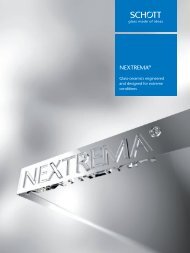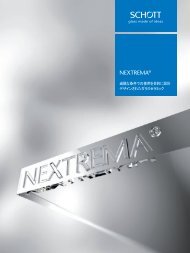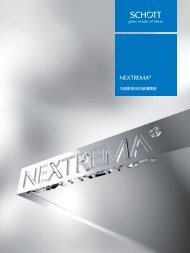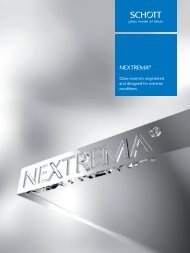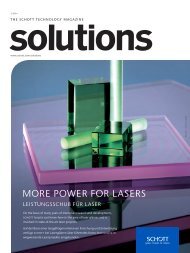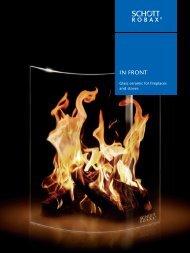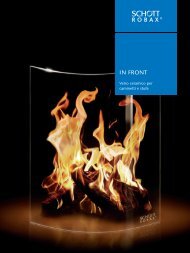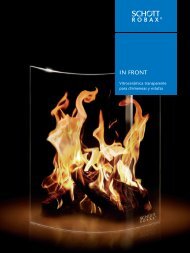SCHOTT Technical Glasses
Apart from its application in optics, glass as a technical material has exerted a formative influence on the development of important technological fields such as chemistry, pharmaceutics, automotive, optics, optoelectronics and information technology. SCHOTT Technical Glasses offers pertinent information in concise form. It contains general information for the determination and evaluation of important glass properties and also informs about specific chemical and physical characteristics and possible applications of the commercial technical glasses produced by SCHOTT. With this brochure, we hope to assist scientists, engineers, and designers in making the appropriate choice and make optimum use of SCHOTT products.
Apart from its application in optics, glass as a technical material has exerted a formative influence on the development of important technological fields such as chemistry, pharmaceutics, automotive, optics, optoelectronics and information technology. SCHOTT Technical Glasses offers pertinent information in concise form. It contains general information for the determination and evaluation of important glass properties and also informs about specific chemical and physical characteristics and possible applications of the commercial technical glasses produced by SCHOTT. With this brochure, we hope to assist scientists, engineers, and designers in making the appropriate choice and make optimum use of SCHOTT products.
You also want an ePaper? Increase the reach of your titles
YUMPU automatically turns print PDFs into web optimized ePapers that Google loves.
13<br />
Because even highly resistant materials such as non-alkaline<br />
earth and alkaline earth borosilicate glasses react to a very<br />
small degree with the surrounding media, the fulfillment<br />
of this requirement is a question of quantity and detection<br />
limits. Concentrations of 10 –6 – 10 –9 (i.e. trace amounts),<br />
which are measurable today with highly sophisticated analytical<br />
instruments, can be released even from borosilicate<br />
glasses in the form of SiO 2 , B 2 O 3 , and Na 2 O, depending on<br />
the conditions. However, solutions in contact with highgrade<br />
colorless DURAN ® laboratory glass will not be contaminated<br />
by Fe, Cr, Mn, Zn, Pb, or other heavy-metal ions.<br />
In the case of less resistant glasses, small amounts of water<br />
(air moisture and condensation) in the presence of other<br />
agents such as carbon dioxide or sulfur oxides can lead to<br />
surface damage. In the case of sensitive glasses, hand perspiration<br />
or impurities left by detergents can sometimes induce<br />
strongly adhering surface defects, mostly recognizable<br />
as stains. If the contaminated glass surfaces are reheated<br />
(> 350 – 400 °C), the contaminants or some of their components<br />
may burn in. Normal cleaning processes will then<br />
be ineffective and the whole surface layer will have to be<br />
removed (e.g. by etching).<br />
2<br />
2.3.3 Undesirable glass surface changes<br />
When an appreciable interaction between a glass surface<br />
and aqueous solutions occurs, there is an ion exchange in<br />
which the easily soluble glass components are replaced by<br />
H + or OH – ions. This depletion of certain glass components<br />
in the surface leads to a corresponding enrichment in silica,<br />
which is poorly soluble, and thus to the formation of a socalled<br />
silica-gel layer. This layer proves, in most cases, to be<br />
more resistant than the base glass. When its thickness exceeds<br />
about 0.1 – 0.2 µm, interference colors caused by the<br />
different refractive indices of layer and base glass make this<br />
silica-gel layer visible to the unaided eye. With increasing<br />
layer thickness, it becomes opaque and finally peels off, destroying<br />
the glass.<br />
In the case of technical laboratory glass, the first stages are<br />
only a question of aesthetics. The functionality of the glass<br />
is not influenced in any way. In optical glasses, however, interference<br />
colors and opacity are usually unacceptable, and<br />
in glasses for electrical engineering, applicability may be reduced.<br />
In the final stage of degradation, when the silica-gel<br />
layer peels off, the glass of course becomes useless for any<br />
application.<br />
2.3.4 Desirable chemical reactions with the glass surface<br />
(etching)<br />
Very strong reactions between aqueous agents and glass<br />
can be used for fundamental cleaning of glass. The complete<br />
ablation of glass layers leads to the formation of a new<br />
surface.<br />
Hydrofluoric acid reacts most strongly with glass. Because<br />
it forms poorly soluble fluorides with a great number of<br />
glass constituents, it is mostly only used in diluted form.<br />
The best etching effect is usually achieved when another<br />
acid (e.g., hydrochloric or nitric acid) is added. A mixture of<br />
seven parts by volume of water, two parts of concentrated<br />
hydrochloric acid (c = 38 %) and one part of hydrofluoric<br />
acid (c = 40 %) is recommended for a moderate surface ablation<br />
of highly resistant borosilicate glasses. When chemically<br />
less resistant glasses (e.g. 8245, 8250) are exposed for<br />
five minutes to a stirred solution at room temperature, surface<br />
layers with thicknesses of 1 – 10 µm are ablated, and a<br />
transparent, smooth, completely new surface is produced.<br />
<strong>Glasses</strong> can also be ablated using alkaline solutions, but the<br />
alkaline etching process is much less effective.<br />
Between these stages there is a wide scope of possible surface<br />
modifications, some of which, although optically visible,<br />
are of no practical significance, whereas others must be<br />
considered.


